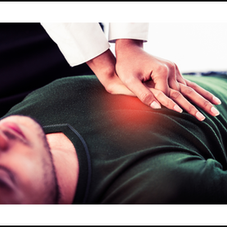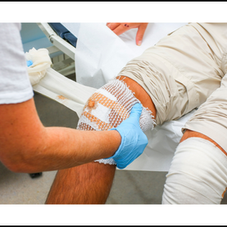Medical Syndromes For Your OIIQ Exam
Arterial Steal Syndrome - or dialysis-associated steal syndrome (DASS) is a syndrome caused by ischemia (not enough blood flow) resulting from a vascular access device (such as an arteriovenous fistula or synthetic vascular graft–AV fistula) that was installed to provide access for the inflow and outflow of blood during hemodialysis. S/S: •Pallor •Diminished pulses (distal to the fistula) •Necrosis •Decreased wrist-brachial. Tx: The fistula flow can be restricted through banding, or modulated through surgical revision.
Carpal Tunnel Syndrome - Compression of the Median Nerve. Pain and paresthesia over distribution of the median nerve. Tx: Endoscopic release for CTS. Teaching: Position hand in neutral position, and apply splint when sleeping.
Compartment Syndrome - occurs when pressure increases within one or more compartments (fascia), leading to decreased blood flow, tissue ischemia, and neurovascular impairment. Assessment: Neurovascular signs. S/S: 6P's, Unrelieved or increased pain in the limb. Tissue that is distal to the involved area becomes pale, dusky, or edematous. Pain with passive movement and joint dysfunction. Pulselessness and loss of sensation (paresthesia). Interventions: Notify the physician immediately and prepare to assist. If severe, assist with fasciotomy to relieve pressure and restore tissue perfusion. Loosen tight dressing or bivalve restrictive cast as prescribed.
Cushing's Syndrome - Hypersecretion of cortisol - moon face, wasting of limbs, buffalo hump, bone decalcification, corticoid diabetes, hypertension. Tx: Adrenalectomy
Disequilibrium Syndrome - is a rapid change in the composition of the extracellular fluid occurs during dialysis. Assessment: •Nausea and vomiting •Headache •Hypertension •Restlessness and agitation •Muscle cramps •Confusion •Seizures. Interventions: •Slow or stop the dialysis •Notify the physician •Reduce environmental stimuli •Administer hypertonic IV solution, albumin or mannitol as prescribed •Dialyze the patient for shorter period at reduced flow rate.
Down Syndrome - Trisomy 21, having 3rd copy of chromosome 21 - mental retardation, simian crease, low set and round ear, stunted growth.
Dumping Syndrome - Rapid emptying of the gastric contents into the small intestine that occurs following gastric resection. Assessment: Nausea and vomiting. Feelings of abdominal fullness and cramping. Diarrhea. Palpitation. Tachycardia. Perspiration. Weakness. Dizziness, and Borborygmi. Management: Avoid fluids after meal, lie down or rest after meal, have a small frequent meal. Avoid dairy products, too hot or cold, sweets, and spicy food.

Fetal Alcohol Syndrome or Fetal Alcohol Spectrum Disorders (FASD) - is an umbrella term used to describe the range of effects that can occur in an individual whose mother consumed alcohol during pregnancy. •Low birth weight •Failure to thrive •Developmental delays •Poor memory •Epilepsy •Small head circumference •Organ dysfunction •Poor coordination and lack of fine motor skills. S/S: Jitterness, physical abnormalities, congenital anomalies, and growth deficits. Prevention: Avoid alcohol during pregnancy.
Guillain-Barré Syndrome - Progressive nerve degeneration causing progressive loss of muscle function. Tingling or prickly sensations in your fingers and toes, muscle weakness, difficulty walking steadily, difficulty moving eyes or face, talking, chewing, or swallowing, severe lower back pain, loss of bladder control, fast heart rate, difficulty breathing paralysis. The goal of treatment is to lessen the severity of the immune attack and support your body functions (for example, lung function) while your nervous system recovers. Tx: Plasmapheresis
Hyperglycemic-Hyperosmolar Nonketotic Syndrome (HHNS) - Extreme hyperglycemia occurs without ketoacidosis. More common in type 2 diabetes mellitus. Tx: Volume replacement, treat hyperglycemia, correct electrolyte imbalance.
Immobilization Syndrome - is one of the unfortunate consequences of prolonged bed rest and inactivity. • The lack of activity that may accompany aging reduces one’s endurance to physical effort and may lead to a loss of autonomy. Older people are more prone to developing Immobilization Syndrome. Complications: • Fatigue and shortness of breath • Palpitations when resting or with mild exertion • Dizziness • Risk of embolism or blood clot in a vein (thrombophlebitis) • Increased risk of pneumonia. MUSCLES AND BONES • Osteoporosis with risk of fracture • Reduced muscular strength, which can lead to falls and the fear of falling • Change in upright posture linked to difficulty walking • Stiffness, aches, and pain. Management: Immobilization Syndrome is reversible if a patient begins to move around as soon as possible.
Irritable Bowel Syndrome - Functional bowel disorder characterized by abdominal discomfort, bloating, alteration of bowel habits in absence of any detectable organic cause.
Korsakoff's Syndrome - Loss of short term memory due to alcoholism caused by severe deficiency of thiamine (vitamin B-1). Tx: Oral supplements of thiamine and other vitamins. Alcohol drinking cessation.
Malabsorption syndrome - not gaining weight caused by damage to the intestine from infection, inflammation, trauma, or surgery. prolonged use of antibiotics. other conditions such as celiac disease, Crohn's disease, chronic pancreatitis, or cystic fibrosis. lactase deficiency, or lactose intolerance.
Metabolic Syndrome - Risk factors: Obesity (Low HDL, high LDL, Abdominal fats, high triglycerides), Hypertension, High blood glucose. Mgt.: Diet and exercise.
Neglect Syndrome (Unilateral Neglect) - Patient unaware of the existence of his or her paralyzed side. Tx: Treatment consists of finding ways to bring the patient's attention toward the left, usually done incrementally, by going just a few degrees past midline, and progressing from there. Rehabilitation of neglect is often carried out by neuropsychologists, occupational therapist, speech-language pathologists, neurologic music therapists, physical therapists, optometrists, and orthoptists.
Neuroleptic Malignant Syndrome - is a rare, but life-threatening, idiosyncratic reaction to neuroleptic medications that is characterized by fever, muscular rigidity, altered mental status, and autonomic dysfunction. NMS often occurs shortly after the initiation of neuroleptic treatment, or after dose increases. Ex of meds that causes NMS: chlorpromazine and second-generation antipsychotic drugs (eg,clozapine, risperidone, olanzapine). Tx: STOP the antipsychotic medication, Medications: Dopamine agonists (supplementing dopamine) e.g., bromocriptine or Parlodel. Muscle relaxant e.g., dantrolene sodium or Dantrium. Supportive measures such as providing adequate fluids and hydration. Decrease fever.
Oculo-respiratory syndrome - is a usually transient condition characterized by bilateral conjunctivitis, facial edema, and upper respiratory symptoms following influenza immunization. Symptoms typically appear 2 to 24 hours after vaccination and resolve within 48 hours of onset. Tx: Rest, antipyretic, increase fluids and food intake, report to MD is S/S persist.
Restless Legs Syndrome - or Willis-Ekbom Disease. A neurological disorder characterized by an irresistible urge to move one's body to stop uncomfortable or odd sensations. Causes: CRF, pregnancy, alcoholism, neuropathy. Tx: Relieving symptoms by movement or treating the medical condition.
Reye's Syndrome - Loss of consciousness and seizures in kids, after viral infection (flu or chicken pox) is treated with Aspirin. S/S: Diarrhea, rapid breathing, vomiting, lethargy, decrease LOC. Prevention: Use caution when giving aspirin.
Shaken baby syndrome - is a serious brain injury caused by forcefully and violently shaking a baby. Other names for this condition include abusive head trauma, shaken impactsyndrome, and whiplash shake syndrome. Shaken baby syndrome is a form of child abuse that causes severe brain damage.
Steven Johnson Syndrome - is a rare, serious disorder of your skin and mucous membranes. It's usually a reaction to a medication or an infection. Often, it begins with flu-like symptoms, followed by a painful red or purplish rash that spreads and blisters. Causes: Infection (HIV, Herpes, Pneumonia, Hepatitis A and medications (anti-gout, pain reliever i.e. Tylenol, anticonvulsant, penicillin). Management: Prevention
Serotonin Syndrome - is a group of symptoms that may occur following use of certain serotonergic medications (SSRI) or drugs. The degree of symptoms can range from mild to severe. Symptoms include high body temperature, agitation, increased reflexes, tremor, sweating, dilated pupils, and diarrhea.
Syndrome of Inappropriate Antidiuretic Hormone (SIADH) - Excess ADH is released, but not in response to the body’s need for it. Caused by trauma, stroke, lung and pancreas malignancies, medication, stress. Assessment: Signs of fluid overload, Changes in level of consciousness and mental status changes, Weight gain, Hypertension, Tachycardia, Anorexia, Nausea and vomiting, Hyponatremia. Interventions: Monitor vital signs, neurological, and cardiovascular, Provide a safe environment, particularly for patient with changes in level of consciousness or mental status, Monitor intake and output and obtain weight daily, Monitor fluid and electrolyte balance, Monitor serum and urine osmolarity, Restrict fluid intake as prescribed, Administer medications as prescribed: Diuretics, Declomycin, IV fluids (NS or hypertonic saline), Monitor closely due to risk of fluid overload, IV solutions with water is contraindicated due to risk of water intoxication.
Sudden Infant Death Syndrome: Sudden death of an infant ≤ 1 y/o (cause: unknown). Management: Teaching on SIDS prevention (No cosleeping, have a firm mattress, no pillows or toys inside the crib, regulate the room temperature etc...).
Vena Cava Syndrome (Supine Hypotensive Syndrome) - Occurs when venous return to the heart in insufficient due to the weight of uterus. Vena cava and descending aorta is partially occluded leading to decrease in cardiac output, cardiac return and BLOOD PRESSURE. S/S: Faintness, light-headedness, dizziness, Hypotension, Fetal distress. Tx: Position the patient in left lateral recumbent position to shift the weight of the fetus off the inferior vena cava. Monitor vital signs and fetal heart rate.
To pass your Ordre des infirmières et infirmiers du Québec OIIQ-RN Exam go to: www.rn101questionbank.com
To pass your Ordre des infirmières et infirmiers auxiliaires du Québec OIIAQ-LPN Exam go to: www.rn101lpnquestionbank.com
Follow us on Instagram for more free nursing materials: https://www.instagram.com/jimbriant/




















